
15 minute read
Two Door Cinema Club: False Alarm Tour

Two Door Cinema Club ascended from the indie ether in 2010 with their platinum-selling debut LP Tourist History. In the six years that followed, the Northern Irish band toured the world, headlined festivals and frontman Alex Trimble sang as part of Danny Boyle’s 2012 London Olympics opening ceremony. After dropping Beacon in 2012 and Gameshow in 2016 – both albums charting in the Official UK Albums Chart top five, the band took a well-deserved studio hiatus in 2016. Now returning to the stage with the release of their highly anticipated fourth album and tour, False Alarm, the three-piece have upped the ante, with bigger and better production values than ever before.
PRODUCTION Having worked with the band during their previous album cycle in 2016 - 2017, Tour and Production Manager, Bennie Brongers returned to TDCC crew roster this year following his stint with alt-J. Ahead of the band’s landmark arena show in London’s O2 Arena, Brongers shared: “We have a core group so it’s a bit of a family affair.” The PM outlined two people specifically, who he dubbed his “left and right hand” on this tour, Gloria Marce and Jason Fearnley – both of whom have toured with Brongers for six years. “Gloria tends to handle all things backstage on the day, such as travel related paperwork, final advancing for travel and more,” stated Brongers. “Jason deals with all things on and around the stage like backline, carnets, and working on the practicality of the design elements.” Equally as loyal were his suppliers of choice: Lights Control Rigging (LCR), Britannia Row Productions, Colonel Tom Touring, Brilliant, Popcorn Catering, Stardes and Beat The Street. Brongers retraced his history with suppliers. “Although I may have my personal preferences, as far as audio
and lighting, I listen to the engineers, before deciding on which vendors to bring, as they are the ones who have to make it work. For this run all the supply companies have offered an excellent service.” On the subject of demand, Brongers explained that while budget is always an issue, thanks to his mutual, longstanding relationships with the suppliers, he was given fair prices. “Personally, I prefer more stability throughout the year, rather than a company whose prices may fluctuate depending on stock. In my experience with longstanding relationships comes loyalty and trust, something that means an awful lot, especially in hours of need.” Ha ving skipped production rehearsals and jumped straight into Motorpoint Arena Cardiff, Brongers said the team was ready an hour before soundcheck. “The crew have excelled themselves to deal with the demands,” he commented.
VISUALS A stalwart of TDCC’s production design and creative direction, Chris ‘Squib’ Swain has worked with the band for nine years, the last three alongside Dan Hill under the banner of Cassius Creative. In keeping with the show’s bold and clean aesthetic, more video was used than on previous tours. “With the backbone of the show being the three-side panoramic video surface – then supported by simple lighting – we’re able to maintain a clean, contemporary feel to the live show,” the design team explained. “It can have a variety of dynamic looks, yet also be scaleable as required around the world.” After consulting the band and developing a mood board, Cassius Creative was clear on how the live show should look feel. “The idea was to
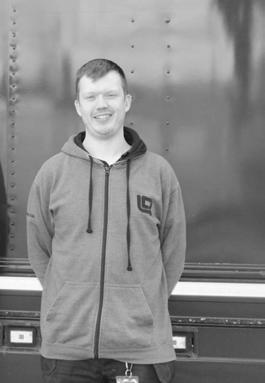

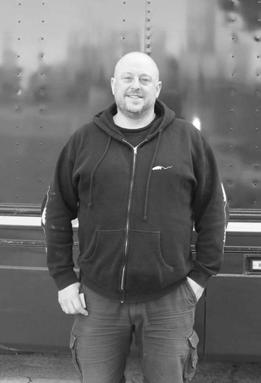
Lighting and Video Crew Boss, Harrison Cooke; Stage Technician, Jacopo Fois; Stage Manager, Jason Fearnley. Monitor Engineer, Steve Donovon, FOH Engineer, Ian Laughton & Systems Technician, Cesar Lopez; Tour and Production Manager, Bennie Brongers.
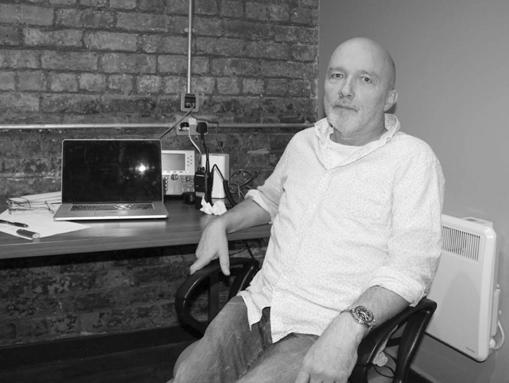
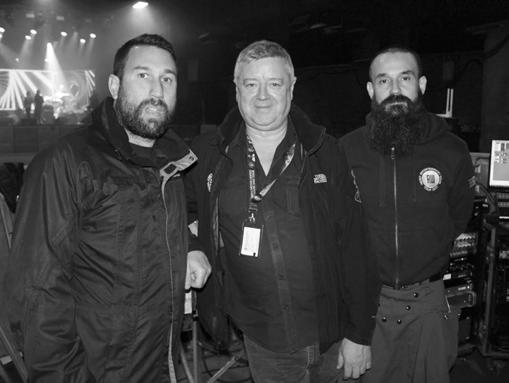
create a simple yet impactful looking show that varies dynamically, from feeling very heightened and intense to, moments of bold simplicity. We aimed to incorporate the band’s new album themes and the style of the new artwork into the live show.” It was here that the versatility of the set design and different lighting strategies created very different visuals. “The idea was to create a recognisable identity for TDCC,” the duo informed TPi. “Regardless of the direction lighting and video takes, at its core, there is a sleek and recognisable look to the stage, with the riser layout that frames the band and provides a tiered environment for them to perform in.” Five red beacon ‘siren’ lights were used, both as a practical light source in keeping with the False Alarm theme, but also as a structural scenic element, looming above the band as a finishing touch to the otherwise minimal set. The creatives outlined: “We purposefully kept the lighting rig very simple, using blocks of colour and shapes. We kept the programming structural and rhythmic, avoiding wiggly beam looks or delicate gobo lighting effects in favour of bold punches and beat-driven intensity or colour effects.” Cassius Creative worked closely with Adam Young at Fray Studios, who created the video content, to assure visual cohesiveness. With the video taking such a prominent position on stage in relation to the band, “it was important that nothing was overreaching or distracting,” Young said. “Video content needed to act nicely as a framing device for the band and drive the energy of the music forward visually.” For the new campaign content, the creatives drew inspiration from the album artwork, which featured everyday objects presented in a new way.
“For all of these looks, we kept the colour palette primary and minimal, limiting each element to two colours. We also ensured that all of the objects were instantly recognisable – this level of simplicity allowed us to choreograph their movements and create some big clean looks for each song,” Young explained. Fo r a selection of songs, Fray Studios created the video content from scratch using a combination of After Effects and C4D. “C4D, along with an offsite render farm, gave us flexibility when it came to shape, pattern and rhythm,” Young continued. “We built all of the 3D elements like the megaphones and clocks and ensured they were all rigged correctly to allow us to do what we needed to do. Once we made it to rehearsals, the set-up and workflow meant that we were able to change things meaningfully and quickly on site according to the content on the LED screen.” He summed up his experience: “Two Door have a huge back catalogue. It was a lot of fun creating things for new unheard material as well as older classics.” Lighting the way on the road was Director and Operator, Liam Ashton. “More songs and content have been added since I joined the timecoded show, so I’ve been responsible for the day-to-day programming and upkeep,” he commented. A rotating setlist depended on the band’s input, playing out every variation possible for the eventual O2 Arena, London setlist. “It’s a really easy camp to come into as long as you’re professional and pulling your weight. For me, it’s a different role because I’m usually on the operational and technical side, rather than operating a console.” Fo r control, Ashton utilised an MA Lighting grandMA2 light console,

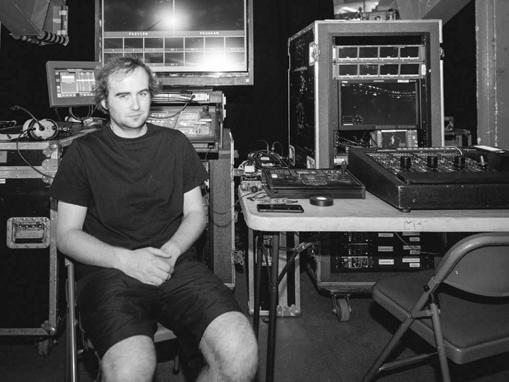
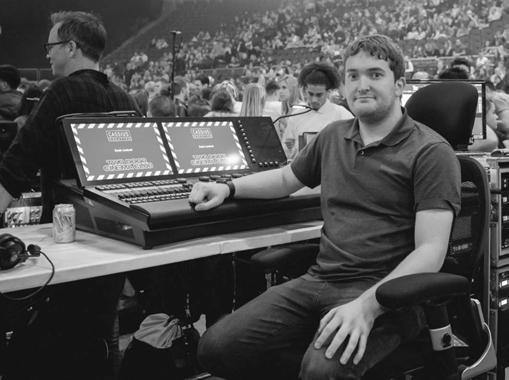

Dimmer Technician Ben Eastham; Camera Director Charles Woods. Video Programmer Joe Lott; Creative Director, Chris ‘Squib’ Swain & Lighting Director and Operator, Liam Ashton.
opting for full sizes in the United States due to the availability of vendors. “The grandMA2 is my console of choice,” he said. “I was very lucky that it was one of the very first consoles I learnt on.” The main touring lighting comprised a linear row of 49 GLP JDC1s below the video screen, with eight TMB Solaris Flares used for bright, coloured side light – as well as 14 GLP JDC1s set behind the screen, for a glow behind and around it to help blend lighting and video. A further 12 SGM P-10s were specified for uplighting the back cyclorama and providing enough brightness to hold its own against the panoramic LED screen, which it helped frame. Ashton described the design as “flashy and big”. He commented: “Lighting is driven by the energy of the band on stage,” although there was a lot of colour in the front wash and side light, there are also points where it is quite dark and silhouetted. “Most importantly, it’s about the band.” The flown rig used two linear rows of 45 GLP JDC1s and 52 Robe Spiiders for a bright ceiling of wash light. Single Claypaky Unico spots were placed above each band member, with the band key’d from the front – with each member in a pair of Robe BMFLs were fitted with long through lenses, to keep them lit well wherever they roamed. For the song Satellite, Cassius Creative used a 3D animated clock face. One of the busier, more energetic lighting looks, it used striking blocks of blue and yellow, adding energy from the white strobe cells of the GLP JDC1s. The creatives worked closely with Mike Oates at LCR on many projects, and having looked after the last TDCC campaign in 2016, the design team praised the supplier – along with Colonel Tom Touring, which was brought in to supply an extensive video and an camera package for the O2 Arena,
London date – for “providing a great service” over the years. Lighting and Video Crew Boss, Harrison Cooke, commented: “The band definitely have an aesthetic and they’re involved with every step of that process, so it’s been great to help facilitate their vision.” Cassius Creative also worked closely with Brongers and Fearnley to deploy a set of bespoke dollies in the UK and US, allowing the crew to tour its usual panoramic video screen into many venues and roll on at festivals. “It allows us to push what would often not be possible, but the design can work with off-the-shelf elements around the world for an almost identical looking live show,” the designers noted. A video screen made up of ROE Visual CB5s with Brompton processing enclosed the band to illustrate their importance as the focal point of the show, while the media was driven via Green Hippo servers. At its core, the arena design was a scaled-up version of the show, with an embellished screen layout to accommodate IMAG and cameras in a cohesive way; but the aesthetic, content and feel of the overall show remained the same. The lighting crew comprised Lighting Rigger, Paul Burke; Dimmer Technician, Ben Eastham; Lighting Technicians, Aidan Cartmell, Gaz Horridge and Chris Wynn. While the video crew was made up of Video Engineer, Phil Mead and Stuart Heaney; Lead LED Screen Technician, Tony Whitehead; LED Screen Technicians, Chris Clarke and William Whitehead, Media Server Programmer Joe Lott and Camera Director Charles Woods. Cooke concluded: “It’s rare you come into a camp where everybody is a core team, works seamlessly and integrates well. It’s not decompartmentalised – it’s a nice environment to work in.”



AUDIO “I’ve worked with many bands, but these guys are beautiful human beings to hang out with – and what’s more, they’re very talented,” opened FOH Engineer, Ian Laughton, who has been with the band for four years. “This time, we’re certainly kicking it up a notch in terms of production design.” In reference to frontman Trimble’s penchant for putting down his guitar and parading the stage, mic in hand, Laughton quipped: “It’s great to work with a band that are comfortable on stage.” Laughton mixed on a Midas PRO2 console. “I’m kind of an old-school mixer,” he revealed. “I have scenes for all the songs but not that much changes. It’s definitely a hands-on approach because every room is different.” The main speaker arrays of the extensive L-Acoustics PA system included two main hangs of K1, two main underhangs of K2 enclosures, KS28 subs stacked aside and additional Karas as front fills, all processed by L-Acoustics LA-RAK IIs and LA12Xs. “It’s like mixing a rock band live,” he commented. “If you listen to the album, it’s different – it has more of a pop feel.” Highlights of Lawton’s outboard equipment included a TC M6000 Multichannel-FX Processor with I-CON Remote “to give it that punchy analogue sound”, an Avalon VT-737SP Preamp, Massenburg GML 89000 Compressor, Lake Processing LM44 and a Klark Teknik DN9650 digital network bridge. “I’ve had this rack for nine years,” he enthused. “Brit Row purchased the GML especially for me, and they’re quite pricey, vintage pieces of gear. Although they’ve started remaking them at a lower price, the originals are something else. It’s adds a sheen to my mix.” La ughton also waxed lyrical about a new addition to his FOH setup. “We have just been given a Universal Audio Live Rack, which we’re testing on the road. At some point, we’ll have to make the inevitable jump to the digital side. In the likes of Japan, you sometimes can’t get your hands on a GML or
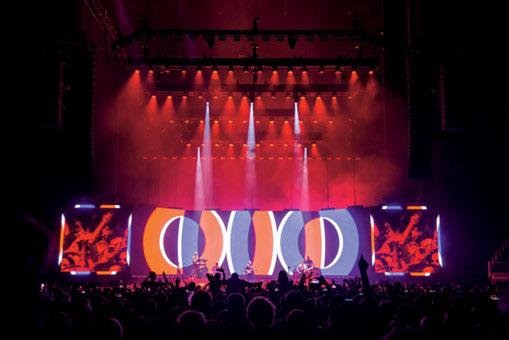
Avalon, so the Universal Audio Live Rack is ideal.” Jo ining Laughton was Steve Donovan, though typically stationed in the caverns of monitor world. “It’s a smaller crew than what people might consider ‘normal’, but as we try hard not to departmentalise, it works really well,” he told TPi. “We also know that production have our back and will do whatever is within their means to get the equipment we need to do our part of the show properly. We don’t carry consoles when we fly in and out of remote places, for example, but, all will be done to make sure we get the right kit provided locally, even when this means an additional cost. And that’s reassuring for us as crew, who have to make it all work.” Li ke FOH, the monitors are mixed with the Midas touch, a PRO2C DL431 mic split with the duel pre-amp which, according to Donovan, “sounds wicked”. With 56 channels and three DL442 analogue output cards, Donovan described the mixing consoles as “almost maxed out on both ends”. He laughed: “I’ve got two local channels – if we had another keyboard we’d be in trouble and there are zero outputs left!” Sennheiser 2000 Series IEM’s are his number one choice. “We freight around our own in-ears, so we don’t need to rent,” he said. “On top of the usual independent band and tech mixes, I also have a guest mix, which is in there providing someone turns up at one of the dates.” On stage, a large portion of the mics were Sennheiser, with additional mics from Shure. “Alex is the only person on stage with a guitar amp,” Donovan shared. “The rest are on Kempers.” Br itannia Row Productions deployed a further three crewmembers: Stage Technician, Jacopo Fois and System Technicians, Cezar Lopez and Giacomo Gasparini – two of which hailed from the famed Britannia Row Training scheme. Laughton had nothing but praise for the audio vendor: “I’ve been using Brit Row for a long time, and now their partnership with Clair Global is fantastic. We can walk into any region and find Brit Row gear.”


Popcorn Catering’s Danielle Scoggins, Em Franklin & Tom Grierson; The Robe RobeSpots in action; FOH Engineer, Ian Laughton; Lighting Director and Operator, Liam Ashton.
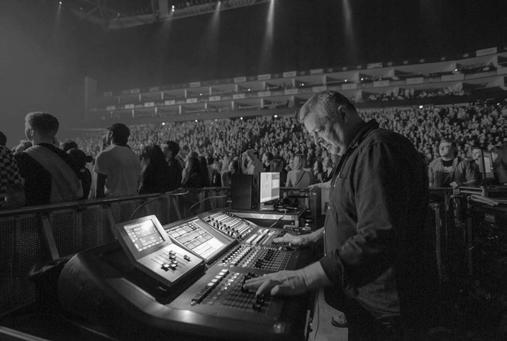
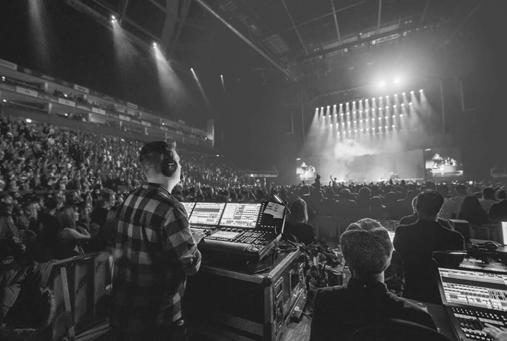
LOGISTICS While Brongers handled the advanced production, Stage Manager, Jason Fearnley, a self-confessed “utility man”, was in charge on and around the stage on the day. Fearnley also held the title of drum tech along with helping out with lighting, video and set elements where required. “I’m basically a fixer,” he joked. “If nobody else is doing it, it’s usually my job.” As the drums evolved and became electric as opposed to primarily acoustic, the stage managing took over as the band got bigger. “We’ve ended up with a lot more set, so I’ve been handling that, keeping it a nice size of production.” Between two to three trucks were specified for the smaller tour dates, while the O2 Arena, London date, saw the addition of four extra trucks – one for PA, and three with lights and video. Fearnley worked closely with Stardes Lead Driver Becky Swan to ensure that the kit got from A to B and the load in and out was as smooth as possible. “Becky is amazing and proper team member,” he said. Fearnley also oversaw the deployment and allocation of the core touring personnel. “It becomes less personal when you’ve got 50 members of crew,” he explained. “We get to tour together and visit places across the world. Hats off to our other two backline techs, Ben Doyle and Paul ‘PJ’ Johnson. They’re two top lads, who are very good at their jobs, and always willing to jump in and help out where required.” Fearnley gave his assessment of the end product: “It’s a very upbeat show with no lull in the set. The set has a dynamic flow, which you have to dance along with, the lighting is fantastic and visually impactful. The L-Acoustics rig also makes it sound incredible.”
Scoggins, tasked with looking after the set up and hospitality for dressing rooms and then overseeing the dinner service. Starting the leg in Cardiff before finishing in Plymouth, the caterers prepared for a fluctuation of management, guests, family and friends at the O2 Arena, London show. “We’ll up the numbers of hospitality and add more room to catering accordingly. We cater for everyone, all dietary requirements and allergens. The band are really lovely and laid back, so it’s been an absolute pleasure to feed them.”
CONCLUSION A million miles away from indie rock’s preppier, pop past, False Alarm evokes a sense of shared, mild nervousness that many gig-goers experience currently; lives are lived in a continual stream of notifications, the end-isnigh news headlines and general despondency. While not masquerading as the supposed antidote, TDCC’s latest live offering sees the band tour with increased production values worthy of the band’s vast back catalogue of hits. Laughton said it best: “They’re not trying to conquer the world – they just want to play music to those who want to hear it.” TPi Photos: Joe Okpako www.twodoorcinemaclub.com www.cassiuscreative.co.uk www.lcr-rental.com www.coloneltomtouring.com www.fraystudio.co.uk www.britanniarow.com www.popcorncatering.com www.stardes.uk www.beatthestreet.net


